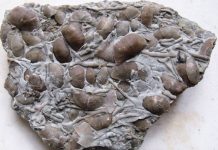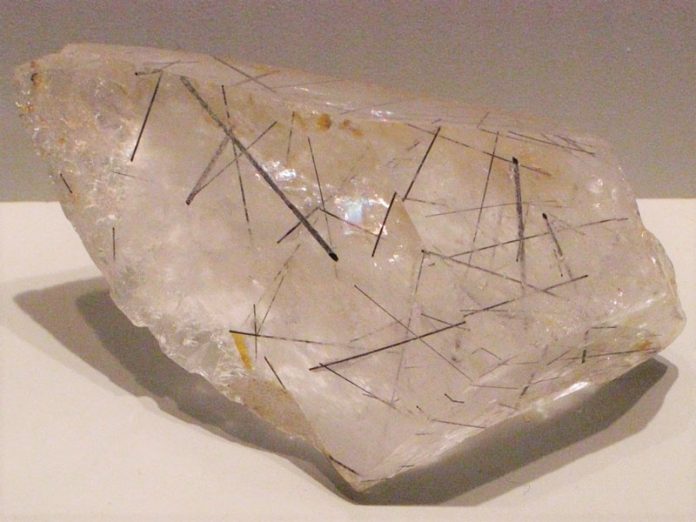
Different types of inclusions in quartz can create beautiful and unique gemstones! Quartz inclusions take one of the most common minerals on Earth to a new level of science and beauty. Think quartz is common? Think again! As mineralogist John Sinkankas observed, “One could devote an entire lifetime to collecting examples of inclusions occurring only in quartz!”
What is an Inclusion?
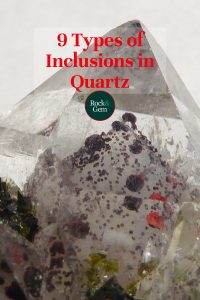
At its most basic, an inclusion is a material that was trapped inside a mineral as it formed. Quartz is referred to as a host if it contains other minerals within itself. These other minerals, in turn, are referred to as inclusions. Inclusions can look like locks of golden hair, fuzzy moss or even floating spheres.
With precious gemstones, inclusions are an indicator of a natural versus a synthetic stone. Completely flawless stones are rare in nature, so a lack of imperfection screams synthetic and often lowers the value. But with quartz, when you add the imperfection of inclusions, the value can jump exponentially. An ordinary quartz crystal with dings can fetch as much as $200 if it has even a small inclusion of sky-blue ajoite. Google “tourmaline in quartz” and the price might be $150, even if the quartz crystal is hohum and the tourmaline is common black schorl.
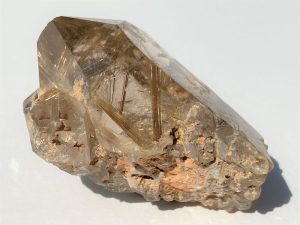
What is Quartz?
Quartz is silicon dioxide (SiO2). You find it as crystals, masses, agates and jaspers, opals and other staples forming the basic diet of most lapidary artists.
Perfectly formed crystals are called euhedral, with eu meaning “good” or “ideal.”
A euhedral crystal is one that is bounded by regular, well-developed faces. With quartz, there are six faces, making it a hexagonal crystal. Pure quartz, often referred to as rock crystal, is colorless and transparent. It looks much like ice. Indeed, ancient Greeks believed it to be ice that never melts because gods crafted it deep within Earth. The Greek word krystallos means “ice.”
Quartz often is divided into crystalline, or large visible crystals, and cryptocrystalline, which includes agate and jasper with fibrous aggregates of microscopic crystals. This article focuses on larger, crystalline varieties of quartz.
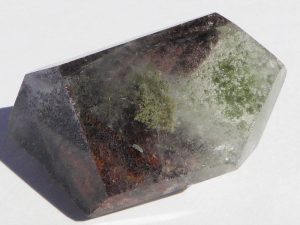
Types Inclusions in Quartz
Quartz crystals forming in vugs or cavities (as opposed to solidifying out of magma) often begin under high temperatures and pressures as molecules in a solution that is aqueous, or water-based. Within the solution, silica atoms attract one another because of chemical and electrical forces.
They interlock and grow in repeating crystal patterns dictated by the chemistry of the constituent elements. As they grow, the surrounding solution can change. Thus, the crystal might stop growing for a time, then start growing again. In between, other elements might get introduced and form other minerals that get incorporated into the quartz crystal. All sorts of things might happen depending on the atomic and mineral nourishment received from the ever-changing solution.
Inclusions may form before, after, or at the same time as the host crystal. They may consist of other minerals, light dustings or druses, gases or fluids, or natural fissures and cracks.
Protogenetic Inclusions
A protogenetic inclusion happens when a mineral inclusion grows first and a quartz crystal grows around it. Often, quartz is one of the last minerals to solidify out of a solution. Thus, a mineral-like rutile might form on a cavity wall and later be enveloped by quartz, forming so-called sagenitic sprays.
There are specimens where the quartz crystal stopped growing and rutile needles project out of the quartz crystal face.
Syngenetic Inclusions
Inclusions formed at the same time that the host was growing are called syngenetic inclusions. At times, a quartz crystal pauses in its growth and a mineral settles on the crystal face only to get incorporated inside the quartz if it begins to grow again. When this happens, you see what’s called a phantom inside the quartz crystal or you may see what appears to be perfectly formed crystals of minerals like fluorite or garnet “floating” inside the quartz.
Rather than floating, they have adhered to a previous growth phase of the quartz crystal before it continued its growth.
Gazing into a phantom crystal, you literally see the past in the ghostly form of the crystal’s former shapes. In addition to larger crystals, you might see tiny bubbles or mineral grains coating earlier crystal faces that stopped growing. When they started growing again, the coatings became trapped in a thin layer. Sometimes, this happens over and over again, faithfully marking the crystal’s growth zones much like growth rings recorded in trees.
Epigenetic Inclusions
Some inclusions form after a quartz crystal completes its growth. This might include fractures or other internal damage due to natural processes like heat, pressure or radioactivity. Or it might include so-called alteration products (a mineral that changed because of heat and pressure).
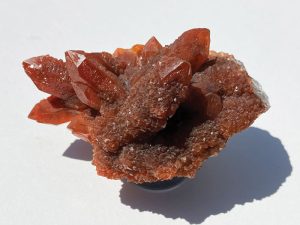
Common Types of Inclusions in Quartz Often Encountered
Entire collections have been made of the varied inclusions within quartz crystals. The following are common examples that can easily be collected in the field or at gem shows.
Rutilated (Sagenitic) Quartz
Rutilated or sagenitic quartz contains gold-colored rutile inclusions. Sometimes these are in delicate fanned patterns like sprays of blonde hair or feathers. Other times, they are acicular (needle-like) clusters. These have been called hairstones, Venus’ hair, Cupid’s darts, or fleches d’amour (“arrows of love”). Sometimes the rutile needles radiate out in starburst fashion from a cluster of hematite crystals. This is called “star rutile.” Rutilated quartz most commonly comes from Bahia, Brazil.
Tourmalinated Quartz or Tourmaline Quartz
Tourmalinated quartz contains long, thin tourmaline crystals. Often, these are common black schorl but they also may be more precious pink or green elbaite. These are found in pegmatite deposits worldwide, including the Pala region of southern California.
Chlorite, Actinolite, and Amphibole Phantoms
The minerals chlorite, actinolite, and amphibole can leave green to black dustings on phantom faces within a quartz crystal. But sometimes they form dramatic fuzzy clumps that look for all the world like moss or plants. Quartz crystals with such inclusions are highly prized and sought.
Iron Oxides
Iron oxides like hematite can grow as small red dots or plates that might be visible as dustings on a phantom crystal face. If there is an especially large abundance of hematite plates, the whole crystal may have a bloodred cast and you need a loop to see the platelets within.
Larger Mineral Crystals
Many nicely formed crystals of other minerals are sometimes seen floating within a quartz crystal. Most often, they aren’t really floating. Rather, they have adhered to a phantom crystal face. You commonly see such crystals as pyrite, fluorite or garnet.
Fluid and Gas Inclusions
Fun specimens are quartz crystals where the dealer has circled an area with a Sharpie marker. This is done to help buyers see inclusions of liquids and bubbles that rock back and forth in tiny cavities within the quartz.
Such inclusions can be used to determine the heat and pressure at which the original crystal formed. Scientists determine this by heating a quartz crystal until the bubble or fluid exsolves or disappears.
Some quartz crystals are completely filled with gas and liquid inclusions trapped as veils and wisps within minute cavities. They make the entire crystal white and opaque. Such crystals are popularly known as milky quartz.
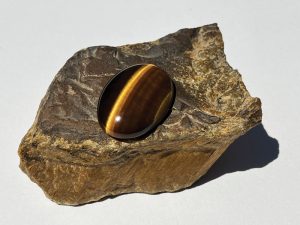
Inclusions in Quartz Causing Interesting Optical Effects
Other inclusions create almost magical optical effects because of the way they are aligned within the quartz host.
Chatoyancy, or Cat’s Eye
Chatoyancy is an optical effect created by tiny tubes or slender crystal inclusions lined up and packed tightly in a row within a host mineral. Jiggle the stone back and forth under bright light and a shining streak running at a right angle to the inclusions can be seen, particularly when the stone is cabbed or otherwise rounded. It looks much like the slitted pupil of a cat’s eye.
This effect is strong with tiger’s eye quartz from South Africa. The inclusion, in this case, starts out as crocidolite, a variety of fibrous asbestos. Quartz grows over the crocidolite and is dissolved and replaced in a process that results in a pseudomorph. The crocidolite is entirely replaced by the quartz, but its finely fibrous structure remains along with a staining of iron minerals, giving the quartz a silky golden sheen with fine chatoyancy.
Asterism or Star Stones
Asterism is an optical effect showing two or three crossed lines that look like stars with four or six rays radiating out from the center. Star stones occur when extremely fine microscopic needle-like inclusions of minerals like rutile orient themselves to the internal six-sided crystal structure of quartz during a process called exsolution.
The inclusions are so fine they are normally invisible to the eye. It is these inclusions that reflect light, showing a shimmering star. This effect can be seen when the stone is cut as a cabochon or rounded as a sphere.
Deposits giving rise to star rose quartz have been found in India, Sri Lanka, Brazil, the Ontario province of Canada and California’s Greenhorn Mountains.
Aventurescence
Aligned inclusions can produce an optical effect known as aventurescence. Small green fuchsite (“chrome mica”) plates line up in mutual orientation as quartz forms and incorporate them. This usually happens with massive deposits of quartz as opposed to discrete crystals. The result, when cabbed, looks like a stone containing sparkling metallic confetti. Green-spangled aventurine quartz is common in the area of Madras, India.
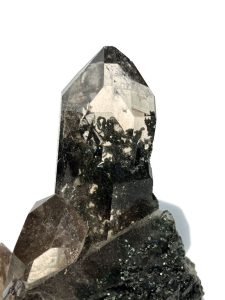
Included Quartz as a Lapidary Stone
While inclusion in any sort of gemstone material is often considered an undesirable flaw, when clear and inexpensive quartz is used for faceting, cabbing, or carving, an inclusion is viewed as an enhancement.
Rutilated quartz, in particular, is considered desirable. If a quartz crystal hosting inclusions is broken or otherwise not very aesthetic as a crystal specimen, it can serve as a prime candidate for a wonderful piece of jewelry, whether cabbed or faceted.
Precious metals like gold or silver might be included, as from the Sixteen to One Mine in California. These, too, make for wonderful— and valuable—cabochons for mounting into rings, brooches or other jewelry.
Think quartz is common? Think again!
How wonderful it is to be included!
This story about inclusions in quartz previously appeared in Rock & Gem magazine. Click here to subscribe. Story by Jim Brace-Thompson.


